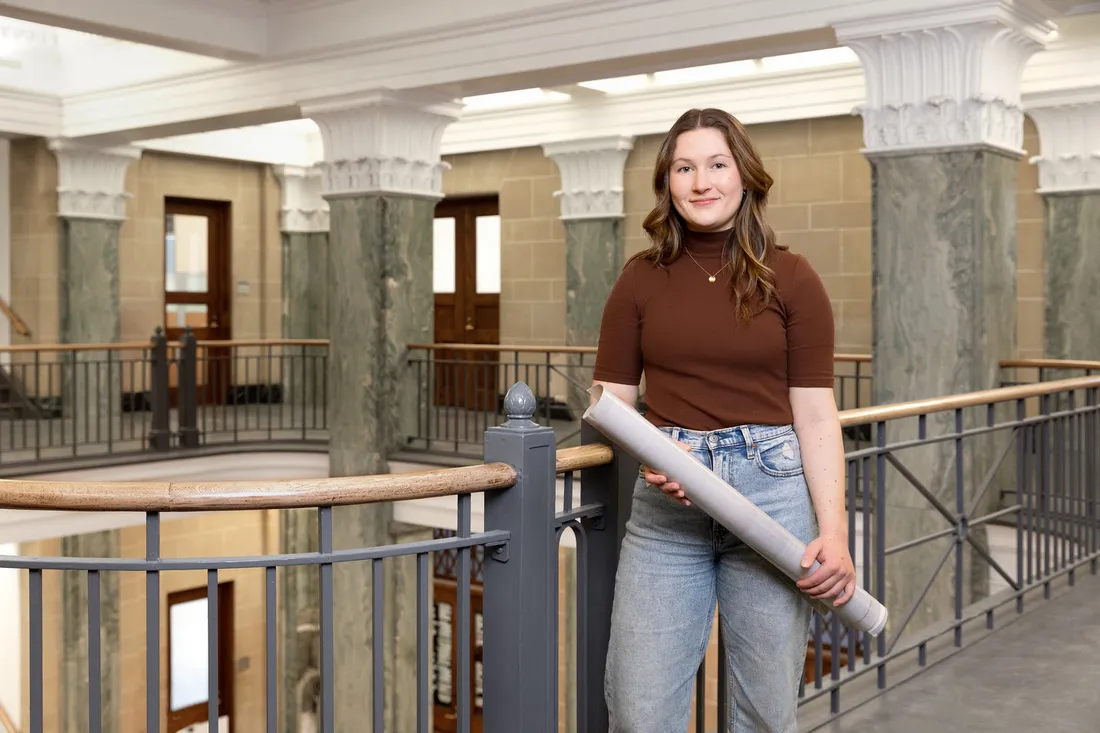
Erin Zearfoss ’23 (standing) shares her findings with fellow students, faculty and external critics. Her project was inspired by the Bauhaus school of art, design and architecture.
“Technology is the answer, but what was the question?” asked British architect Cedric Price some 50 years ago.

Architecture Professors Mark Linder and Emily Pellicano ’00, G’04 co-teach courses that are part of the University’s response to the AI boom.
Students in Syracuse University’s School of Architecture are putting his provocation to the test in professional programs that are as compelling as the technology informing them. Under the guidance of Professors Mark Linder and Emily Pellicano ’00, G’04, graduate and undergraduate students alike are discovering how new advances in artificial intelligence (AI) can impact architectural design.
Linder and Pellicano co-lead a two-course series that reflects not only their own research interests, but also the University’s response to the AI boom. “By working collaboratively with our students, we engage in a range of architectural problems, identities and projects,” Pellicano says. “This creates a shared framework where we teach and learn from one another.”
Redefining the Role and Identity of the Architect
This past year, six teams of students participated in what Linder describes as “research-driven, speculative architectural imaging projects.” Over two semesters, students worked in a cloud-based environment, curating AI-generated elements—words, sounds, images and video—in real time. In April, they presented their findings via a large-format triple projector while leading a spirited discussion about research techniques and potential applications.
Some students used chatbots, like ChatGPT, to gather, analyze and generate content. Others relied on image generators, like DALL-E and Midjourney, to create uncanny synthetic photos.
By working collaboratively with our students, we engage in a range of architectural problems, identities and projects.
Professor Emily Pellicano ’00, G’04
The goal wasn’t to design buildings—although each project had the “potential to be further developed, aesthetically and materially,” Pellicano says. Rather, students experimented with new techniques and processes. “We’re redefining the role and identity of the architect who collaborates with machine intelligence,” she continues. “This means rethinking the traditional phases of design.”

Architecture students work in a cloud-based environment, curating AI-generated elements in real time.
Projects ranged from “visualizing possible futures” of a mobile home park destroyed by climate change to conceiving immersive spaces that respond to human emotions.
Seniors Xinqi “Cindy” Meng ’23 and Haihui “Philip” Zhu ’23 re-imagined Cedric Price’s Fun Palace—an interactive cultural complex that was designed in 1964 but never built. Using a mix of AI-generated imagery, they devised an entirely new virtual version of Price’s building. The narrator was none other than Price himself, courtesy of an AI voice generator.
“We’re complementing traditional memorials with a new approach to commemoration,” Zhu says.
Likewise, seniors Madeline Alves ’23 and Erin Zearfoss ’23 breathed new life into the Bauhaus, a mid-20th-century school of art, design and architecture. The result was “The Babhaus,” a curious collection of digitally generated images.
AI is unprecedented because of its capacity to autonomously mimic human intelligence in peculiar ways and to operate as a collaborator in real time.
Professor Mark Linder
“In imagining a possible future with AI, the past becomes altered through our understanding of its contributions to an alternate present,” says Alves, noting her and Zearfoss’ interpretations of Bauhaus stage designs, furniture, textiles and figurines.
The duo also showcased contributions from textile designer Anni Albers and dancer Loïe Fuller, giving the male-dominated Bauhaus a counterfactual edge.

Julia Kazubowski (left) and Chloe DeMarco, both from the Class of 2023, use AI to conceive immersive spaces that respond to human emotions.
Pushing the Boundaries of Artificial Intelligence Imagination
“At least since the invention of perspective, architectural theory and design has used technologies as forms of artificial imagination,” Linder says. “AI is unprecedented because of its capacity to autonomously mimic human intelligence in peculiar ways and to operate as a collaborator in real time.”
His and Pellicano’s work continues next year as a fall seminar and, in the spring, as an inaugural Directed Research course—one of the first of its kind in Architecture. Moreover, they will compile, archive and test AI-related content with help from three research assistants funded by the Syracuse Office of Undergraduate Research and Creative Engagement.
“These AI projects raise a lot of ethical and philosophical questions,” says architect and theorist David Ruy, one of three external critics invited to comment on the students’ work. “A big one is ‘What’s the role of play in architecture?’ AI doesn’t have to be dark and moody. It can be fun and beneficial to the entire learning process.”


